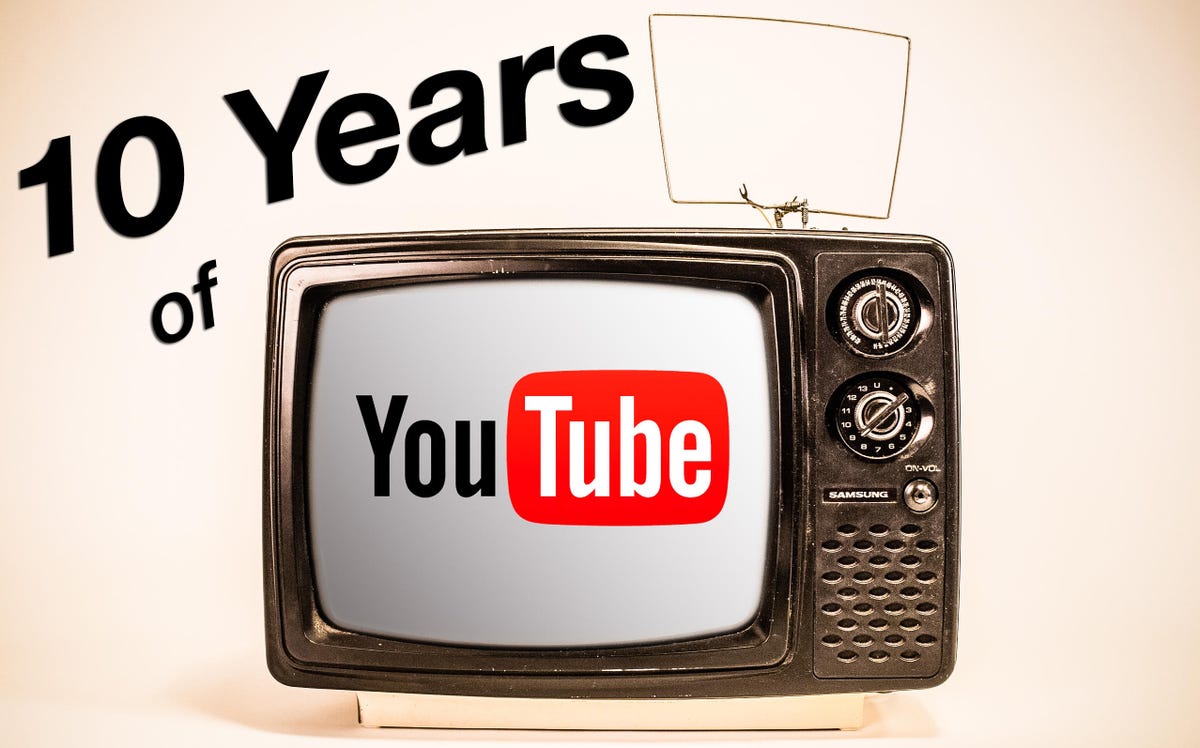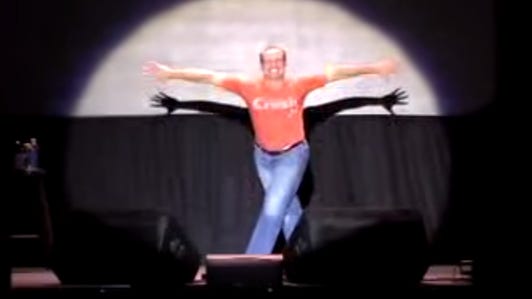
James Martin/CNET
Ten years ago today, a startup called YouTube uploaded its first video.
Co-founder Jawed Karim, in a private test of the fledgling service’s capabilities, posted a short video of himself at the San Diego Zoo. The 18-second clip shows Karim unenthusiastically noting how elephants have “really really really long, um, trunks. And that’s cool. And that’s pretty much all there is to say.”
Actually, there’s a lot to say. From that modest beginning, a mammoth has evolved.
It’s difficult to overstate just how big YouTube is: By the time you finish watching Karim’s “Me at the zoo,” other YouTube viewers around the globe will have collectively watched more than seven years worth of video. In the time it takes to watch that test video two more times, about 12 days of footage will have been uploaded to Google’s video site.
Today, YouTube attracts more than 1 billion unique visitors a month — or one out of every seven people on the planet. And that audience is helping create online stars. Today’s fastest-rising celebrities aren’t coming out of Hollywood. They’re teens hamming it up or breaking it down in front of the computer to create a new kind of entertainment.
YouTube turns 10
- Generation YouTube: Today’s fastest-rising stars aren’t coming out of Hollywood
- Viral stars of YouTube (pictures)
- Meet Smosh: Big stars on small screens (Q&A)
- Four tidbits on YouTube star Michelle Phan even fans won’t know
That dominance wasn’t a foregone conclusion. In 2006, Google paid $1.65 billion for YouTube, which was founded by Karim along with entrepreneurs Chad Hurley and Steve Chen. The sheer might of its parent, though, didn’t guarantee success. (How frequently do you check your Google+ social network, for example?) Several factors early in YouTube’s existence played out in its favor and set it on the path to becoming the biggest media platform on the planet.
“No one organization has done more for creatives in the whole history of humanity than Google or YouTube,” said Will Keenan, who heads the US digital division of television production giant Endemol.
Utilitarian start
YouTube’s main attraction at first wasn’t the videos you could watch but the files you could store online. The founders wanted to create an easy way to share videos, not necessarily a place to sit back and let others watch them. At a time when video files were large and online storage capabilities for them were scarce, YouTube’s appeal was in its role as an early version of now popular cloud-based service Dropbox.


Screenshot by Richard Nieva/CNET
“People were already videotaping at that time, but they had no way to store that content,” recalled Zefr cofounder Rich Raddon, whose company helps studios manage their copyrighted material on YouTube. “It was more of an archivist point of view.”
Here, Google’s resources were key.
“They were really able to benefit from Google’s scale,” said Laszlo Bock, Google’s head of human resources. Bock started at Google in 2006, the same year the search engine bought YouTube. For Google, the challenge was finding a balance between getting involved enough to be helpful but not a hindrance.
One of Google’s perks was its arsenal of technology. The infrastructure needed to sustain heavy usage was daunting for a startup but not for one of the Internet’s biggest companies.
“It was necessary that the platform got bought early by Google because the sheer costs to store and code and stream all that video were massive,” said Raddon. Google’s data centers around the world distributed content to make it quick to access so viewers didn’t have to wait for videos to load. “When you hit play, there isn’t that much buffering because that content had been spread out, localized throughout the world.”
The un-TV
YouTube was one of many sites striving to be the the Web’s home for free video. One way it set itself apart was by letting its users figure out what the site should be, rather than prescribing that YouTube should feel like “real” television.
“A bunch of services out there, they really thought they were going to be TV,” said Jim Louderback, who ran multichannel network Revision3 and is now an editorial director of the VidCon conference on online video. “YouTube looked at themselves and said, ‘What’s going to make it easy for people to share video? We’re going to let it be what it is.”‘
That democratic approach extended to elements reminiscent of social networks. Unlike the inherent distance that rests between TV and its audience, performers and viewers on YouTube could form interactive online communities. YouTube’s most successful “creators” quickly learned that being accessible and authentic on the platform was crucial for building a fan following.
In fact, some of YouTube’s most memorable videos are of a tearful teen defending Britney Spears and a gangly graduate student singing a song called “Chocolate Rain” in a Barry White-like voice.
Viral stars of YouTube (pictures)






+7 more
“It was a platform that was built for us and populated by us,” said Bing Chen, YouTube’s former head of global creator development and management. “Suddenly it became the most social platform in the world.” Chen left YouTube last year to start a company called Victorious, which helps creators launch mobile apps to help promote themselves.
All the world’s stage
While YouTube’s initial appeal was as a place to upload content, it didn’t take long for it to become a site predominantly for watching video. YouTube began to take shape as a platform for publishers, with the most successful often being people with no background in the traditional media world.
The launch of the YouTube Partner Program in December 2007 was a turning point for the service’s evolution into a platform for performance. The Partner Program is how YouTube shares revenue from advertising that plays against a video with the person who uploaded it.
Five years later, YouTube opened that program up from allowing just the producers of very popular content to join, to letting in anyone who wanted to try to make money from their videos. The program went from 30,000 partners to millions within a few months, said Chen. “It opened up the floodgates.”
Louderback said his Revision3 channels had deals with a slew of competitors, sites like Metacafe and Dailymotion, but YouTube was the only one that ever seemed to pay up. “When somebody sends you a check, you’re more likely to keep working with them,” he said.
The second decade
YouTube is spending the month of May celebrating the 10-year mark of its beta site launch.
As YouTube embarks on its next 10 years, it faces more competition than it’s had since those early days. Ad dollars are migrating online, and rivals like Facebook and new ventures like Vessel are beefing up Web video efforts to eat some of YouTube’s lunch. Though Google doesn’t disclose terms, and those terms vary by creator, the site generally is known to share 55 percent of revenue from ads run against an partner’s videos.
But for now, with more than a billion people visiting the site every month, YouTube isn’t sweating it.
“Unless the Internet breaks, YouTube isn’t going anywhere,” Keenan said.




